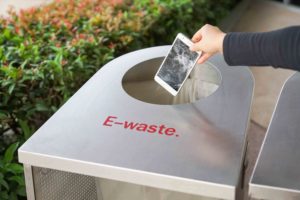Today, customers are more concerned about the environmental credentials of businesses than ever before. By some estimates, One in three people stopped purchasing a product/brand in recent years because of sustainability or ethical concerns, and after a difficult year, in which many businesses have been forced to innovate more just to stay alive, considering the loss of more customers can.
However, if this year has reinforced one principle, it’s that adaptability is the key to longevity. So, while you may already know that efforts to reduce your business’s waste comes with added benefits to your bottom line, using the new year to reinforce a commitment to sustainability could be the best way to adapt to uncertain markets.
To help you plan for a sustainable 2023, we’ve come up with 13 ways that you can reduce your environmental impact in the new year and future-proof your business. From cutting out plastic to encouraging working from home, read our resolutions for a sustainable start to 2023.

Change Your Waste Management Process
A review of your waste management systems is likely to reveal big inefficiencies, from mixing up different kinds of waste to an inflexible collection schedule. Additionally, many businesses could be in violation of new municipal, state, or federal laws for waste disposal without knowing it.
A waste management assessment is the ideal way to do this, giving you a tailored appraisal of how your company currently deals with waste and how you can make improvements. Additionally, you’ll find plenty of waste management resources out there to help you understand the impact of your business.

Recycle or Donate Food Waste
It’s not just restaurants and grocery stores that produce commercial food waste. Almost all business premises are generating food waste on some level via employees, and when you consider that food takes up more space in landfill than anything else, it’s clear that reusing, composting, or recycling food waste is an important intervention at any scale.
For those in hospitality, excess food can be recovered and donated, while smaller, non-food-related enterprises can start by setting up a compost bin in house or arranging for food waste collection.

Say Goodbye to Single-Use Plastics
One of the simplest and most effective steps any business can make is to cut out single-use plastics in day-to-day business operations. Whether this means getting rid of kitchen and bathroom disposables, or switching to new packaging solutions for your customer-bound goods, there are so many innovative alternatives to plastic on the market that there’s really no excuse to keep adding to the problem.

Start a Take Back Program
Extended Producer Responsibility (EPR) is the concept in which those who sell a product take responsibility for the entire lifecycle of that product, from manufacture to eventual disposal. One way in which a business can ensure that their product does not make its way to landfill is to introduce a ‘takeback’ program whereby the customer can return the item to you to take care of in a sustainable fashion.
Many companies have discovered lucrative cost savings via a takeback model, using it to funnel raw materials directly back into their manufacturing process and thus avoiding the costly and environmentally damaging extraction of virgin raw materials.

Consider E-Waste in Your Recycling Program
A more complicated material to dispose of than plastic or paper, e-waste has been neglected in both homes and businesses, leading to toxic chemicals being released into the ground, air, and water. Though common business e-waste like cell phones and modems can feel like a relatively small part of your overall business footprint, their circuit boards and batteries have an outsized impact on the environment.
Recycling them effectively at designated municipal centers or with the help of on-demand waste services we can make sure some of the valuable metals contained within these expensive and complex devices are kept in the loop. As an additional bonus this also reduces the need for new raw materials to be mined.

Offer Flexible Working Hours to Reduce Emissions
Global working patterns have been shaken up in small businesses and large corporations alike these last few years, but one thing we have discovered is that efficiency does not necessarily suffer from employee decentralization, i.e. working from home.
If every one of your employees worked from home just one day in five, it would shave a fifth off your collective commuting carbon emissions each week. On top of this, one study found a 4.8% increase in productivity when employees worked from home one day a week.

Subsidize A Bike to Work Scheme
A great way to improve employee mental health and contribute to a lower carbon footprint for your whole business is to encourage a change in commuting behavior. Some companies, including Amazon, have created their own incentivization schemes to help employees make the shift from crowded trains and buses to taking two wheels. And if biking isn’t an option, consider incentivized carpooling or public transport over numerous individuals driving to work alone every day.

Offset Work Related Travel Emissions
Carbon offsetting may present a more tangible financial cost to your business, but it does have many potential benefits to your brand and, even more significantly, to employee retention. One study suggests that 65% of people (and not just millennials), are more likely to work for a company with strong environmental policies. Climate change is a particularly potent issue, especially for those entering the workplace for the first time, and your action here is increasingly being held up to the light.

Introduce Reusables to Your Office
From biodegradable coffee filters to recyclable paper cups, the alternatives to single-use plastics are growing fast. But why not go a step further and invest in personalized mugs and glasses for each of your employees?
Filtered and refrigerated water in a reusable bottle is just as elegant as wasteful single-use bottles. Plus, filtered water is considered healthier than tap or bottled water. Rethink the stationary cupboard as a place for reusable resources for staff to draw upon, and instead of sticky notes and notepads, encourage paperless alternatives.

Cut Out Paper
Banishing paper from the workplace may seem overwhelming, but more and more businesses are managing to go digital and save money in the process. Start by replacing invoicing and other correspondence with digital versions. Get any old paper records digitized and you’ll ensure your employees have full remote access to their databases and systems.
You’ll save on additional consumables like ink and stationary, plus you’ll free up valuable office space in the process. If going fully paperless is just not an option, small changes like double-sided printing go a long way to cutting down on paper waste.

Reduce Energy Use
Who wouldn’t want to reduce their energy bill? This simple objective can start out small and grow with time. Begin with religiously shutting down all lights and electronics in the evenings, then think about where you can upgrade to more energy efficient equipment like LED bulbs or newer HVAC systems (responsibly recycling your e-waste of course).
Later, bigger steps can be taken to move your reliance away from the main grid; installing solar panels or wind turbines on site to supplement your energy supply. Or you can think about introducing electric vehicles to a company fleet or employee vehicle plan.

Switch to Environmentally Friendly Suppliers
In the spirit of extended producer responsibility, take time at the end of the year to look backwards up your supply chain at who you are doing business with. Are your supplier’s values reflecting your own environmental goals? Consider what raw materials are being used in the manufacture of their components or ingredients.
Palm oil is one to look out for and avoid in cosmetics production. In the garment industry, there’s a growing facility for reusing recycled cotton in new clothing. In hospitality, investigate local sourcing and consider organic, sustainably farmed ingredients that don’t come in plastic packaging.
These are just a handful of areas where you can begin to transform your business into a more environmentally friendly enterprise in 2023. You can find many more resources and helpful information on reducing waste by visiting the RTS blog or by speaking with one of our TRUE Waste Advisors.
For more resources and information on reducing waste visit the RTS blog, and to book a free assessment for your business, speak to our TRUE-Advisors today.

